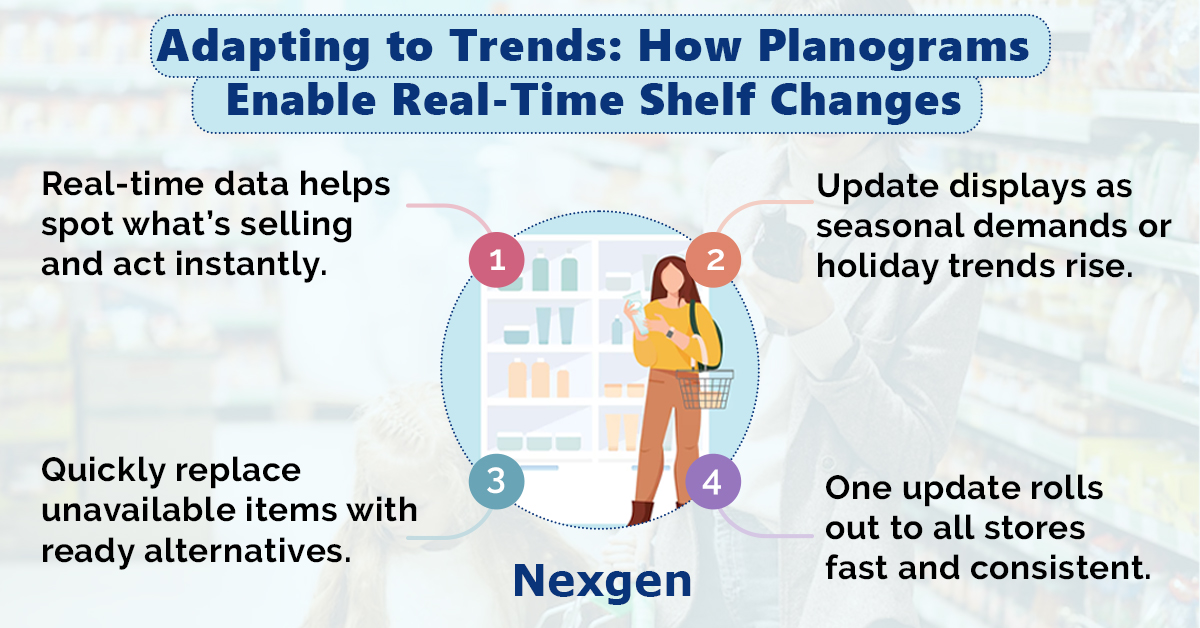In retail, staying relevant means constantly adapting to trends, shifting consumer preferences, and seasonal changes. One of the most efficient ways retailers are staying agile and responsive to these changes is through planograms.
Planograms, also known as visual merchandising or shelf plans, are tools that help retailers map out the optimal arrangement of products on their store shelves. Traditionally, these layouts were static, designed months in advance, and rarely updated once implemented. However, with the advent of real-time data and advanced technology, planograms have evolved. Today, planograms can be adapted quickly and seamlessly to accommodate changes in consumer demand, market trends, and even supply chain fluctuations. Here is how planograms are helping retailers navigate and adapt to trends in real-time:
1. Data-driven insights for agile shelf planning.
The foundation of a modern, adaptable planogram lies in data. With real-time sales and inventory data at their fingertips, retailers can quickly identify trends, such as which products are experiencing a surge in popularity, and which are slowing down. Armed with these insights, retailers can adjust their planograms to reflect these shifts, ensuring popular products are more prominently displayed and slow-moving items are given less space.
For example, during a holiday season, certain seasonal products might see a spike in demand. A retailer can use real-time data to quickly adjust their planogram to feature these items more prominently on the shelves, improving visibility and increasing sales.

2. Quick adaptation to seasonal trends.
Retailers no longer need to wait for a traditional seasonal change to update their planograms. Instead, with digital planograms, they can adjust as trends emerge. If a new fashion trend or a hot new product hits the market, retailers can immediately modify their shelf layouts to highlight these trending items. This adaptability allows stores to stay ahead of the curve, even with short-lived or unexpected trends.
Planogram automation and cloud-based solutions make these changes even faster. Updates can be made centrally and deployed across multiple locations simultaneously, ensuring that every store in a chain or franchise is consistently aligned with the latest market trends.
3. Enhancing cross-merchandising opportunities.
Real-time changes to planograms also enable more dynamic cross-merchandising strategies. For example, if a store is selling a lot of baking supplies, but customers are also showing interest in seasonal decorations, the store can quickly adjust its planogram to group these products together, creating a themed display that appeals to current shopping trends.
Similarly, with the rise of online grocery shopping, planograms can be quickly adjusted to highlight popular items like organic products or gluten-free options, which can be reflected both in-store and online. This helps stores maintain relevance in an increasingly competitive retail landscape.
4. Agility in responding to supply chain disruptions.
The retail industry is no stranger to supply chain disruptions. Whether caused by global events, transportation delays, or product shortages, these disruptions can impact product availability on the shelves. Traditional shelf planning would be a static, rigid process, but with real-time planogram tools, retailers can adapt on the fly.
If certain products are unavailable, retailers can shift their planogram to feature substitute items, ensuring shelves remain stocked and customers are satisfied. Additionally, planograms can help identify alternative products or brands that are available allowing for quick pivoting to maintain store performance despite supply chain challenges.
5. Improved compliance across multiple locations.
For retailers with multiple stores or franchises, keeping planograms consistent across locations while still allowing for flexibility is key. With digital and cloud-based planogram tools, updates made in one location can be quickly propagated across all stores, ensuring consistency while accommodating local preferences or regional trends.
Overview of Nexgen POG
Nexgen POG is a robust and user-friendly cloud-based visual merchandising tool. It is designed for quick and efficient planogramming with minimal effort. Planograms in retail can be designed by easily dragging and dropping the products. The multi-device compatibility feature of POG allows you to obtain, share and edit planogram on any device, including your phone. It helps in designing store-specific planograms for increased product visibility and sales.
Get Your Free Trial Now!